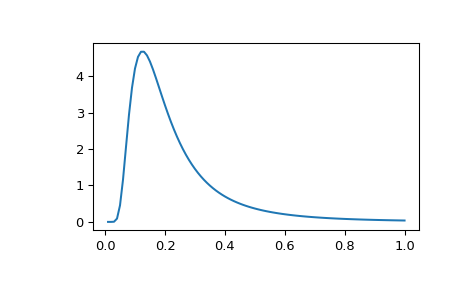scipy.stats.invwishart#
- scipy.stats.invwishart = <scipy.stats._multivariate.invwishart_gen object>[源代码]#
逆 Wishart 随机变量。
df 关键字指定自由度。scale 关键字指定尺度矩阵,它必须是对称和正定的。 在这种上下文中,尺度矩阵通常被解释为多元正态协方差矩阵。
- 参数:
- dfint
自由度,必须大于或等于尺度矩阵的维度
- scalearray_like
分布的对称正定尺度矩阵
- seed{None, int, np.random.RandomState, np.random.Generator}, optional
用于绘制随机变量。 如果 seed 为 None,则使用 RandomState 单例。 如果 seed 是一个整数,则使用一个新的
RandomState实例,并用 seed 作为种子。 如果 seed 已经是一个RandomState或Generator实例,则使用该对象。 默认值为 None。
方法
pdf(x, df, scale)
概率密度函数。
logpdf(x, df, scale)
概率密度函数的对数。
rvs(df, scale, size=1, random_state=None)
从逆 Wishart 分布中抽取随机样本。
entropy(df, scale)
分布的微分熵。
- 引发:
- scipy.linalg.LinAlgError
如果尺度矩阵 scale 不是正定的。
另请参见
注释
尺度矩阵 scale 必须是对称正定矩阵。 不支持奇异矩阵,包括对称半正定情况。 不检查对称性; 仅使用下三角部分。
逆 Wishart 分布通常表示为
\[W_p^{-1}(\nu, \Psi)\]其中 \(\nu\) 是自由度, \(\Psi\) 是 \(p \times p\) 尺度矩阵。
invwishart的概率密度函数支持正定矩阵 \(S\); 如果 \(S \sim W^{-1}_p(\nu, \Sigma)\),则其 PDF 由下式给出\[f(S) = \frac{|\Sigma|^\frac{\nu}{2}}{2^{ \frac{\nu p}{2} } |S|^{\frac{\nu + p + 1}{2}} \Gamma_p \left(\frac{\nu}{2} \right)} \exp\left( -tr(\Sigma S^{-1}) / 2 \right)\]如果 \(S \sim W_p^{-1}(\nu, \Psi)\) (逆 Wishart),则 \(S^{-1} \sim W_p(\nu, \Psi^{-1})\) (Wishart)。
如果尺度矩阵是一维的且等于 1,则逆 Wishart 分布 \(W_1(\nu, 1)\) 将折叠为逆 Gamma 分布,其参数 shape = \(\frac{\nu}{2}\) 和 scale = \(\frac{1}{2}\)。
此处使用 [4] 中的算法直接生成随机逆 Wishart 矩阵,而无需像 [2] 中描述的那样反转随机生成的 Wishart 矩阵。
在 0.16.0 版本中添加。
参考文献
[1]M.L. Eaton, “Multivariate Statistics: A Vector Space Approach”, Wiley, 1983.
[2]M.C. Jones, “Generating Inverse Wishart Matrices”, Communications in Statistics - Simulation and Computation, vol. 14.2, pp.511-514, 1985.
[3]Gupta, M. and Srivastava, S. “Parametric Bayesian Estimation of Differential Entropy and Relative Entropy”. Entropy 12, 818 - 843. 2010.
[4]S.D. Axen, “Efficiently generating inverse-Wishart matrices and their Cholesky factors”, arXiv:2310.15884v1. 2023.
示例
>>> import numpy as np >>> import matplotlib.pyplot as plt >>> from scipy.stats import invwishart, invgamma >>> x = np.linspace(0.01, 1, 100) >>> iw = invwishart.pdf(x, df=6, scale=1) >>> iw[:3] array([ 1.20546865e-15, 5.42497807e-06, 4.45813929e-03]) >>> ig = invgamma.pdf(x, 6/2., scale=1./2) >>> ig[:3] array([ 1.20546865e-15, 5.42497807e-06, 4.45813929e-03]) >>> plt.plot(x, iw) >>> plt.show()

输入分位数可以是任何形状的数组,只要最后一个轴标记组件即可。
或者,可以调用该对象(作为函数)来固定自由度和尺度参数,返回一个“冻结”的逆 Wishart 随机变量
>>> rv = invwishart(df=1, scale=1) >>> # Frozen object with the same methods but holding the given >>> # degrees of freedom and scale fixed.